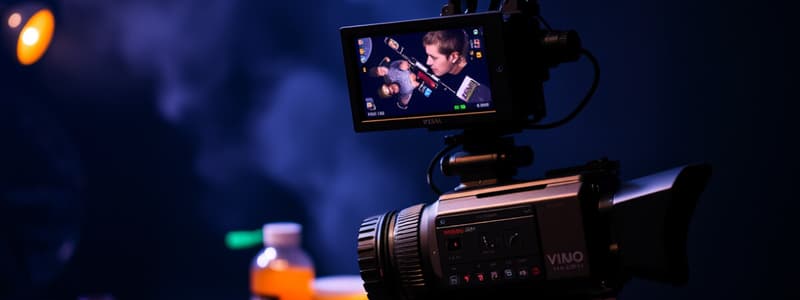Podcast
Questions and Answers
What is the fundamental purpose of a light capture/recording device in filmmaking?
What is the fundamental purpose of a light capture/recording device in filmmaking?
- To edit video footage seamlessly
- To manipulate color saturation in post-production
- To create sound effects during filming
- To project images onto a screen (correct)
Which of the following is essential for maintaining aesthetics in film production?
Which of the following is essential for maintaining aesthetics in film production?
- Application of color theory (correct)
- Focus on dialogue delivery
- Use of a consistent narrative structure
- Inclusion of special effects
In the context of filmmaking, how do powerful lamps function in theatres?
In the context of filmmaking, how do powerful lamps function in theatres?
- To project images through a focusing lens (correct)
- To adjust the film's frame rate
- To enhance the sound quality of the film
- To illuminate the audience for better visibility
What aspect of static fine art remains consistent in filmmaking?
What aspect of static fine art remains consistent in filmmaking?
Which device is used to project images on television?
Which device is used to project images on television?
What is the primary purpose of visual elements in film?
What is the primary purpose of visual elements in film?
Which definition correctly describes a 'frame' in filmmaking?
Which definition correctly describes a 'frame' in filmmaking?
How are 'shots' and 'sequences' related in filmmaking?
How are 'shots' and 'sequences' related in filmmaking?
What is diegetic time in film?
What is diegetic time in film?
What role do elements and principles of visual art play in film?
What role do elements and principles of visual art play in film?
Flashcards
Film's Light Capture Purpose
Film's Light Capture Purpose
To record images for later display.
Film Aesthetics Key
Film Aesthetics Key
Using color effectively for a desired effect.
Theatre Lamp Function
Theatre Lamp Function
Projecting images using a lens to focus.
Film Composition
Film Composition
Signup and view all the flashcards
Film Frame Definition
Film Frame Definition
Signup and view all the flashcards
Film Shots & Sequences
Film Shots & Sequences
Signup and view all the flashcards
Diegetic Film Time
Diegetic Film Time
Signup and view all the flashcards
Film Visual Art Elements
Film Visual Art Elements
Signup and view all the flashcards
Visual Elements in Film
Visual Elements in Film
Signup and view all the flashcards
Static Art in Film
Static Art in Film
Signup and view all the flashcards
Study Notes
The Elements of Filmmaking
- Filmmaking involves a range of essential elements found in every film.
- Image is crucial; it's captured by a light recording device and projected onto a screen using powerful lamps in theatres or via vacuum tubes in television.
- Compositional rules from fine art apply to filmmaking, emphasizing the need for color theory and aesthetic principles.
Visual Elements in Film
- Visual elements should engage the audience subconsciously, guiding them effortlessly from one shot to the next.
- Avoidance of distracting "jump cuts" is essential to maintain continuity and visual flow.
- Films can be critiqued effectively by identifying the intelligent application of visual art elements and principles.
Frame, Shot, and Sequence
- A frame captures a single moment in film or video, akin to a still photograph.
- Multiple frames combine to create a shot, which is an uninterrupted segment of film or video.
- Several shots together form a sequence, establishing a narrative continuity.
Time in Film
- Actual time refers to the film's runtime or duration, essential for audience engagement.
- Diegetic time represents the time within the story, which can range from minutes to years, affecting the narrative's pacing and structure.
Studying That Suits You
Use AI to generate personalized quizzes and flashcards to suit your learning preferences.




